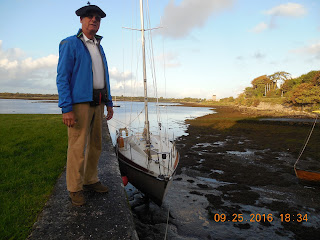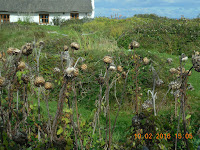HELLO FROM IRELAND
After a short nap, we walked out for dinner and "trad" music at Brogan's Pub. We enjoyed a group of enthusiastic young musicians; two banjos, fiddle, flute and bouzouki.
The next day we walked to historical sights: the Clare Museum, the Ennis Friary, ancient stone bridges, monument to Daniel O'Connell (famous for his 1828 Act of Catholic Emancipation). Afterwards was lunch of St.Tolas cheese tart with caramelized onion, marinated beet greens, mesclun, mixed vegetables and potatoes.

There was another evening of traditional music: at the Poet's Corner of The Old Ground Hotel then ventured to another pub, unknown to most tourists, where Anne Marie and Friends played at James Moroney Family Grocer, with fiddle, guitar, bodhran, concertina, and flute.
It was amusing to see Irish humour everywhere.
The next morning we met John, proud owner of Cycle Holidays Ireland who invited us to visit Limerick before settling into Bunratty. We learned of bastion walls, sally-ports and tunnels at King John's castle. This is a place for real historians and archeologists!
We bussed to the Bunratty Courtyard Guesthouse, our base for the next 2 nights. We walked to Bunratty Castle, village and Folk Park, which was restored by the Gorts who owned the castle for years and returned it to the people of Ireland in their will. After a late tea, we had a lovely dinner at Durty Nellie's Pub, named for a bridge toll collector next to the Castle.
Had fun trying hats in Tourist shops....where could we wear these?
These antlers on the walls are from extinct Irish Elk. This is the Grand Ballroom.
We especially enjoyed the Fairy Garden, and are inspired to make Tree Fairy Houses in Cape Breton.
Our Cycling Tour began from our Bunratty Guesthouse. This was a terrific tour! We were fortunate to have selected the "best" of Ireland Cycling. Our favourable impressions of Cycle Holidays Ireland began with the detailed and informative web site (www.cycleholidaysireland.com)
At last, we met our Specialized bikes, precisely tuned to our individual needs. It is a damp morning, so our rain gear was needed. We are equipped with high visibility jackets, cell phones, handle bar bags and helmets. We are given route maps and information sheets daily. John is only minutes away at all times.
Fine dinner at Gallagher's Seafood
Being along in our years and not expert cyclists, we were concerned that the Irish terrain might be beyond our abilities, even though we cycle regularly at home in similar terrain. Fortunately, the route chosen was not excessively hilly.
Most importantly, John Heagney, company owner, manager and guide was available to transport us up the steepest hills, allowing access to some of the more rugged sections without over-extending ourselves. We relished every drop of Irish sunshine and were happy to shelter in the van on the occasions when the sunshine became too liquid. We appreciated a vigorous outdoor excursion under appropriate adult supervision.
As promised, John was always accessible by phone. He, and the detailed maps provided, kept us safe on beautifully quiet country roads. His "managerial finesse" avoided construction areas, stampeding cattle, dogs and horses, floods, bogs, and heavy car traffic. We never felt rushed and feel we saw more than we anticipated. We found the drivers in Ireland able to manage passing us courteously on single lane roads.
We were pleased with the provided bikes. One wheel went out of true and was immediately replaced with a spare from the van.
The scenery is breath-taking, glen after glen and vista after vista. We were pleased to enjoy first-hand the many animals, plants, fruit and flowers late in the fall (end of Sept). We were able to cycle on the beach and visit a multitude of castles, churches, friaries, and ancient monuments. The mountains, sunrise and sunsets, as well as harbours, were beyond our ability to photograph properly.
At every stop we encountered friendly and competent inn keepers, wait staff, bar tenders and entertaining musicians. Our Irish heritage did not disguise our tourist status, but we were nevertheless always welcomed by fellow pub patrons. Here having fun with some of Catherine's newly met relatives!
There was a large selection of lunch stops and the reserved overnight lodgings were uniformly splendid. Our favourite meals included the abundant local seafood: chowders, fish cakes, pies, mussels and oysters.
John is quite knowledgeable about Irish history and pre-history, geology, politics, and economics. We were glad that he shared his knowledge with us. He entertained controversial topics without sugar-coating. His passion for his country and enjoyment in performing a well-conducted tour were obvious.
We viewed an archeological dig in the Abbey estate which had been determined by aerial view to have potential treasures.
We pedalled on to lovely Crusheen, Carran and Kinvara. Our hotel was the thatch-roofed Merriman Hotel. We explored the waterfront and had dinner at the Pier Head.


In Kinvara, we visited the Dunguaire Castle, built by the O'Hynes family in 1500 on the grounds of a 5th century settlement. It was acquired by a wealthy British woman who enjoyed entertaining there.
We cycled to The Burren, with it's other-worldly scenery. During the Great Famine, recognizing the historical significance of the ancient walls of The Burren, unemployed residents were put to work in the Famine Relief Program restoring stone walls deteriorated over centuries.

Lunch was in Crusheen at Cassidy's Pub on top of a good hill overlooking The Burren. Cassidy's is a former RIC (Royal Irish Constabulary) post, where we sat before the fireplace enjoying the meeting of old Irish friends.

We visited the monastic settlement of Kilmacduagh for tea at the Burren Centre before heading to Lisdoonvarna. This city is known for "matchmaking". It attracts people "looking for love". We had dinner at the Royal Spa Hotel, a well-preserved 1885 hotel with 14 ft ceilings. The town's spas boast cold iron, sulphur, magnesium and iodine baths to cure all variety of maladies.
This Coastline is known as "The Wild Atlantic Way", so Peter and I purchased matching jerseys of Clegg Rock to remember our trip, showing the ocean crashing against Atlantic cliffs.
The Visitor Centre at the Cliffs of Moher offers a diorama of prehistoric Ireland geology. Plate tectonics have moved Ireland from the equator to it's present position. The concept of billions of years of geological time is difficult to grasp.

The next day we visited Ballyvaughn to see the 5000 year old Poulnabrone Dolmen (pool of sorrows), part of a Neolithic/Bronze age tomb and Leamanegue Castle near Kilfenora. We saw the home of widow Murrach Ruah, who purportedly pushed a couple of husbands off the roof to give her son an inheritance.
Poulnabrone Dolmen Neolithic & Bronze Age
The Burren Way Hiking Trail is popular with hikers, and we passed several organized walking groups. A visit to The Burren Perfumery taught us about the flowers that grow year-round. There is a slideshow illustrating the diversity of orchids (24 species) and abundance of pollinating insects in this seemingly desolate landscape.


Doolin is well-known for some of the best trad music. McGann's Pub took good care of us. John introduced us to Irish Mist.
Connemara has a reputation for past illicit distilling, smuggling and general lawlessness. It remains an isolated, serene and mostly undeveloped coastline, famous for the Connemara pony.

The economy was boosted by the opening of the Marconi wireless station which employed many and received it's first message from it's sister station in Cape Breton, NS in 1907.
The arrival of the first non-stop transatlantic flight was in 1919 from St. John's, NL, in just 16 hours. Although they had an crash landing in the bog, it was deemed a successful mission.
Roundstone is another picturesque harbour where we enjoyed 11's tea and brownie.

The next day we visited Ballyvaughn to see the 5000 year old Poulnabrone Dolmen (pool of sorrows), part of a Neolithic/Bronze age tomb and Leamanegue Castle near Kilfenora. We saw the home of widow Murrach Ruah, who purportedly pushed a couple of husbands off the roof to give her son an inheritance.
Back in Galway, we enjoy the Merrick and touring the city, harbour, pubs, meeting folks.
Kylemore Abbey, near Letterfrack, was built in the 19th Century Neolithic Castle by Mitchell Henry, a wealthy English businessman, for his bride who died suddenly on their honeymoon. It is situated scenically between a small lake and the slopes of a grand mountain. It was a convent and a private girl's school during World War II.
On the grounds of Ballyhinch Castle we met fly fishermen in waders hoping for catch and release salmon, trout and grisle. The castle was a perfect place for lunch; devilled whitebait, seafood chowder and brown crab salad on brown bread.
Galway is one of our favourite Irish cities, well-known for oysters and other seafood. We enjoyed lively street scenes and meeting friendly locals in pubs. It is a pedestrian-friendly downtown with buskers, restaurants, churches, universities, museums, castles and historical monuments. And the abundant, music filled, Pubs!


The weather was perfect on the day we took a bus from Galway to the Ros a Mhil Ferry to Inis Mor, the largest of the Aran Islands. It is an "outdoor museum" known for historic culture, geological formations and ancient structures such as the Dun Anoghasa Fort perched atop 60 m-high cliffs overlooking the Atlantic Ocean, and protected by concentric circles of chevalier de frees (stone spikes).
Catherine felt daring at the cliff face!
Peter stayed behind the stone wall!
Lovely variety for lunch, and reasonably priced!
Valuable Aran Isle property
Artichokes grow here, and a Connemara Pony begs for a photo.
From Hueston Rail Station, we caught a convenient bus to the Dublin Airport, the airport shuttle to our Dublin hotel, one overnight there and returned next day to the airport by same shuttle for our return flight to Philadelphia. Sounds complicated, but it functioned flawlessly.
"The person who goes alone can start today. But, if traveling with another, one must wait until that other is ready."
Henry David Thoreau.
Peter and Catherine, now aboard the S/V "Charlotte D" laying Guadeloupe, French West Indies.






























































No comments:
Post a Comment